Swamps
What is a swamp?
Swamps, the most fertile type of wetland, are found on valley floors and in basins. They receive much of their water as runoff from surrounding land which supplies a rich source of nutrients. In their base, swamps have a mixture of decomposing plant matter (peat) and soil. They are very wet so there are often areas of shallow water (see Lakes and shallow water fact sheet). Swamps may be the most common wetland left but more have been drained and cleared than any other type of wetland so those that are left are precious.
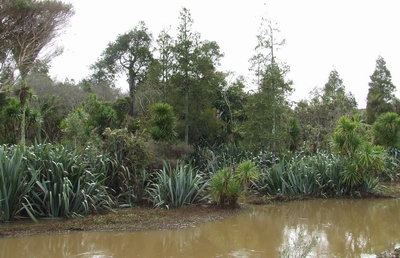 Rotu Bottleneck swamp forest, Dargaville.
Rotu Bottleneck swamp forest, Dargaville.
Why are swamps so important?
Swamps are home to a diverse range of animals and plants that can not live and grow anywhere else. Swamps can be a real asset on any farm, horticultural or forestry block and are worth looking after, restoring or even creating. They act as filters and purifying agents for rivers and streams, improving water quality by filtering out nutrients and sediments from runoff. They act as giant sponges by absorbing water and releasing it slowly to keep streams flowing during dry periods. A good swamp can store up to 10 million litres of water per hectare! Studies in America have also shown that catchments with one third of their area as wetlands or lakes, reduce storm flood peaks by 60-80 percent.
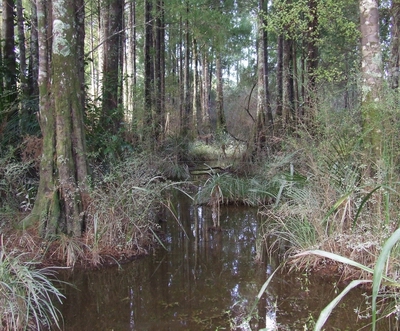 Kahikatea swamp, Dargaville.
Kahikatea swamp, Dargaville.
Vegetation
Because swamps are so fertile they support a diversity of plant life and vary in their appearance. The most common swamps in Northland are raupō and flax swamps. Other plants such as cabbage tree (ti kouka), reeds, rushes, tussock sedges (Carex and Cyperus), swamp millet, and pink bindweed also make a home here. Forests with tall trees are uncommon and have species which tolerate wet feet - kahikatea, pukatea and swamp maire.
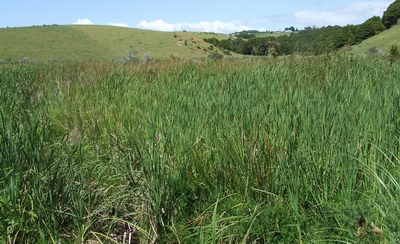 Raupō swamp, Parua Bay.
Raupō swamp, Parua Bay.
Animals
Common birds which are seen in swamps are pukeko, and harrier hawk. Three rare wetland birds are Australasian bittern, spotless crake and fernbird. If your swamp has open water then there will be other bird species especially if you are doing predator control. Open water invites white-faced herons, paradise shell ducks, mallards and possibly even grebes or teal. The golden bell frog is also found in many swamps and their croaking can be heard from a distance. Fish species such as eels and banded kōkopu are also found in swamps especially if they are accessible from the sea.
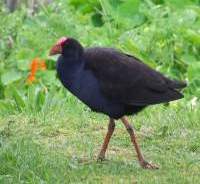
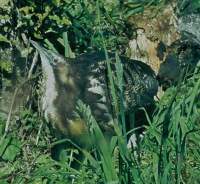
Looking after your swamp
You may be eligible for a Northland Regional Council Environment Fund grant for up to 50 percent of the costs of wetland fencing, pest control and planting.
Hydrology (water levels)
The water in your swamp will fluctuate naturally over the year. However, the way the surrounding land is being managed may be degrading your wetland by influencing water levels. Generally if a wetland looks healthy it means the water levels are stable, even if changes have occurred in the past. Vegetation dieback, weed invasion or a change in the plant community usually indicates that water levels have altered probably because of works nearby. Often this is simple to rectify without lowering the productivity of the surrounding land. It may mean putting in a weir to retain summer water levels, filling in a drain or simply not maintaining a drain.
Remember that before you make any changes to the water levels in a wetland you need to contact the Northland Regional Council as you may need a resource consent.
Plant pests
Maintaining water levels and avoiding drainage and earthworks will help stop invaders such as pampas, gorse and Mexican devil. There are other plants which can establish if your swamp is downstream of a weed source including reed sweet grass (Glyceria), willows, alligator weed, wandering jew and hornwort. Japanese honeysuckle, which is spread by birds, can be difficult to control in flax swamps.
Some herbicides are not allowed to be used over water or in wetlands so please contact a Northland Regional Council Biosecurity Officer for advice before you start.
Here are some things you can do to keep the weeds out:
- Avoid drainage or disturbance that will favour weeds;
- Fence stock out to reduce disturbance and prevent weed spread;
- Wash and dry spades and machinery after working in weedy areas or off farm; and
- Eradicate weeds upstream before they spread.
Animal pests
When it comes to animal pests, there are some basic rules of thumb:
- Wetland birds respond well to basic pest control while others such as brown teal (pateke) and bittern may need a little more help.
- Pest animals in wetlands include possums, stoats, weasels, ferrets, hedgehogs, rats and cats.
- Wandering dogs harass or kill native birds.
- Rabbits, hares, goats and possums browse native plants.
Fencing your wetland is great but it may favour predators so follow fencing with pest control. Fortunately basic predator control is as easy as a line of traps or bait stations around the edge of the wetland.
Contact a Northland Regional Council Biosecurity Officer for advice on the best pest control for your situation and to apply for funding.
Nutrients
Swamps, being fertile systems, are resilient and seem to cope with small amounts of added nutrients. Swamps are well known for the work they do to filter nutrients and sediments however, it is still important that inputs of these things are kept as close to natural levels as possible. Avoid pasture runoff and fertiliser drift and do not allow stock to access wetlands or their margins. When you fence, allow a sufficient margin as a buffer and to capture runoff.
Stock
Stock, especially heavier animals, do a huge amount of damage to swamps so it's not a good idea to use them as a source of summer feed or as a runoff. Pugging breaks through peat damaging the crowns of raupō and other reeds causing these plants to die. Animals browse plants such as flax, cabbage tree, sedges and pukatea. Large swamps or those with deep, wet, peat bases are less vulnerable because stock are unable to push far into them but smaller shallower swamps and swamp forests should be fenced.
Contact the Northland Regional Council for advice on how to apply for funding.
Ponds or dams
Digging a pond in your existing swamp or damming outlets to create open water is not necessarily beneficial for your wetland.
Please contact the Northland Regional Council for advice and before considering creating a dam or pond as you may need a resource consent.
